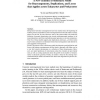Free Online Productivity Tools
i2Speak
i2Symbol
i2OCR
iTex2Img
iWeb2Print
iWeb2Shot
i2Type
iPdf2Split
iPdf2Merge
i2Bopomofo
i2Arabic
i2Style
i2Image
i2PDF
iLatex2Rtf
Sci2ools
RECOMB
2010
Springer
2010
Springer
A New Genomic Evolutionary Model for Rearrangements, Duplications, and Losses That Applies across Eukaryotes and Prokaryotes
Background: Genomic rearrangements have been studied since the beginnings of modern genetics and models for such rearrangements have been the subject of many papers over the last 10 years. However, none of the extant models can predict the evolution of genomic organization into circular unichromosomal genomes (as in most prokaryotes) and linear multichromosomal genomes (as in most eukaryotes). Very few of these models support gene duplications and losses--yet these events may be more common in evolutionary history than rearrangements and themselves cause apparent rearrangements. Results: We propose a new evolutionary model that integrates gene duplications and losses with genome rearrangements and that leads to genomes with either one (or a very few) circular chromosome or a collection of linear chromosomes. Moreover, our model predictions fit observations about the evolution of gene family sizes as well as existing predictions about the growth in the number of chromosomes in eukaryot...
Circular Unichromosomal Genomes | Computational Biology | Genomes | Genomic Rearrangements | RECOMB 2010 |
| Added | 14 Feb 2011 |
| Updated | 14 Feb 2011 |
| Type | Journal |
| Year | 2010 |
| Where | RECOMB |
| Authors | Yu Lin, Bernard M. E. Moret |
Comments (0)

